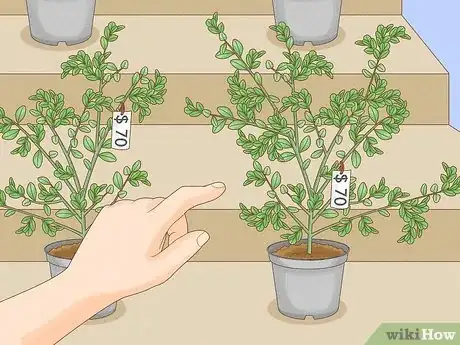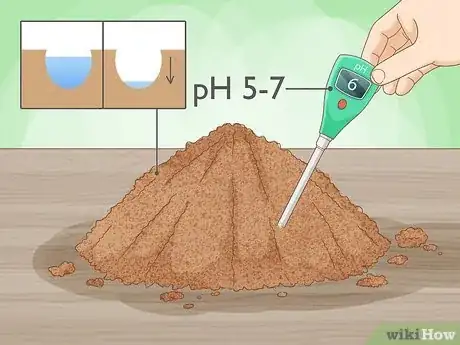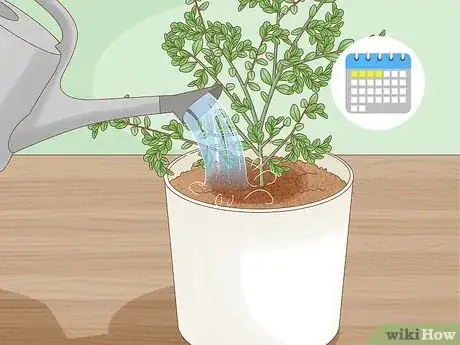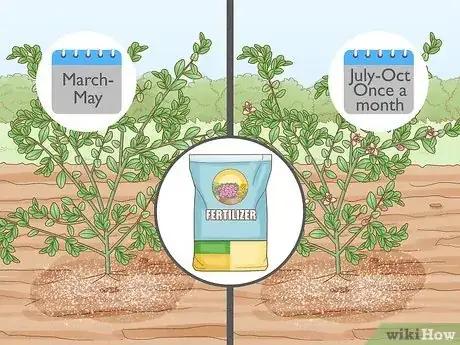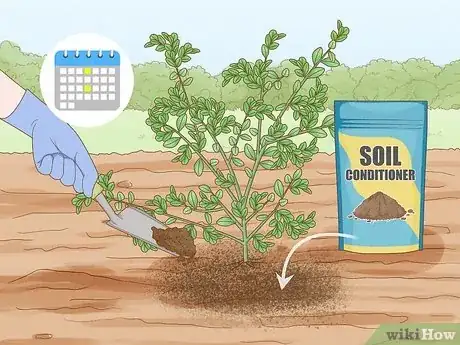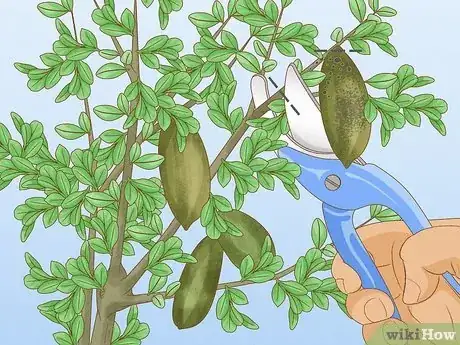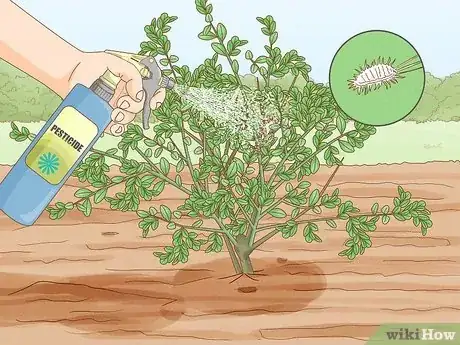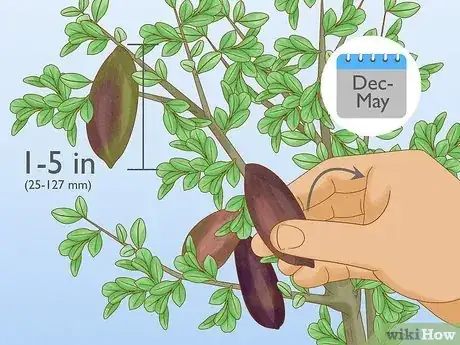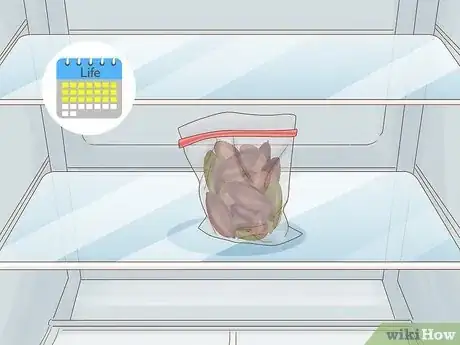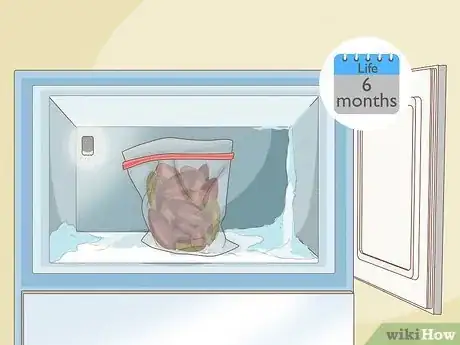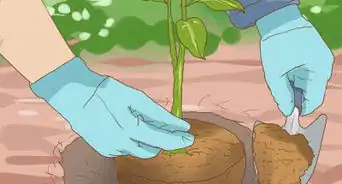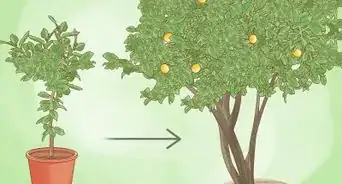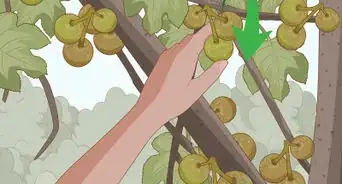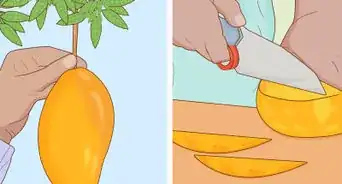This article was co-authored by wikiHow Staff. Our trained team of editors and researchers validate articles for accuracy and comprehensiveness. wikiHow's Content Management Team carefully monitors the work from our editorial staff to ensure that each article is backed by trusted research and meets our high quality standards.
There are 7 references cited in this article, which can be found at the bottom of the page.
wikiHow marks an article as reader-approved once it receives enough positive feedback. In this case, 100% of readers who voted found the article helpful, earning it our reader-approved status.
This article has been viewed 76,816 times.
Learn more...
Finger limes are growing in popularity, especially in culinary circles. The tart citrus fruit is used in desserts, drinks, and sauces. The flesh of finger limes have the consistency of caviar and range in color from green to pink to champagne.[1] Learning how to properly plant, fertilize, prune, and harvest a finger lime tree will help you grow your own source of this “lime caviar.” [2]
Steps
Planting Your Finger Lime Tree
-
1Buy a finger lime tree from a local nursery to harvest fruit next season. A small tree will cost about $70. Even if it starts out small, your tree will yield fruit in 1 to 2 years, depending on when you are able to plant it. [3]
- If your local nursery doesn’t carry finger lime trees, they will most likely be happy to order one for you. All you have to do is ask!
- If you cannot obtain a finger lime tree locally, you can order one from an online nursery.
-
2Use well-draining soil to prevent your tree from growing root mold. Most often, a soil that contains sand will drain well. Finger limes can grow in a wide range of soil—the most important thing to is make sure it won’t be sitting in stagnant water. [4]
- Soil with a pH of 5-7 is recommended for finger limes. When you buy soil, the bag will indicate what the pH level is. If you are uncertain, ask someone at your local nursery for advice. [5]
Advertisement -
3Sow seeds if you are interested in studying growth patterns. You can order finger lime seeds from your local nursery or online, but keep in mind that most trees take up to 15 years to mature to the point of producing fruit. [6]
- If you do opt to plant seeds, make sure to use fresh ones. Even with fresh seeds, the finger lime tree is slow to grow and seedlings have a low success rate. [7]
- Plant seeds in a cell tray with drains about 2 inches (51 mm) deep in the soil. Use your finger to make the hole, then drop a seed into it. Cover it back up with soil. Keep in bright sun (or under a sun lamp) and water every 3-4 days, keeping the soil moist. Once seeds start to sprout, you can replant them in individual pots. Continue moving the seedlings to larger and larger pots as they grow. [8]
-
4Plant your tree outdoors if you live in a warm climate. Places like California and Australia (the native land of the finger lime) have good year-long climates for outdoor citrus plants, in the 60–90 °F (16–32 °C) range. This tree does well in partial shade to direct sunlight. [9]
- Dig a hole in the ground deep enough for the roots of the tree. Place the tree in the hole and fill in the remaining area with additional soil. You want the tree to be able to stand on its own. [10]
- The finger lime tree makes a good hedge and the leaves will grow flat against a wall or lattice. [11]
- Avoid windy locations when planting your tree. The tree has sharp thorns which easily puncture the skin of the finger lime. This is a cosmetic concern, as the fruit should still be usable; it will just be bruised and may leak juice, which can attract pests. [12]
-
5Pot your finger lime tree if you live in an area that gets cold in the winter. While the finger lime can withstand light frost, it will freeze and die if left out in temperatures in the 30–40 °F (−1–4 °C) range. Planting it in a pot will allow you to move it indoors when the weather gets cold. [13]
- Use a 5 US gal (19 L) pot for your finger lime tree. This will give it room to expand and grow roots as the years pass. Make sure there is a hole in the bottom for drainage.
- Fill your pot with soil and then push the dirt in the middle to the sides to bury the roots of your tree. Add more soil around the base of your plant until the pot is full. The soil should fill the pot but should not be packed down. The tree should be able to stand firmly on its own without support. If it doesn’t, you haven’t planted it deep enough. [14]
Caring for and Encouraging New Growth
-
1Water the tree every 3-4 days. In the hottest months, you may need to water more often if the soil is dry to the touch or if it appears crumbly. [15]
- In the winter, you can water less often as the climate won’t be soaking up as much moisture from the soil.
-
2Fertilize your tree from March to May to prepare it for growing season. Use compost, animal manure, or a bag of fertilizer from your local nursery. Fertilizing once per month from July to October to encourage adequate flowering. [16]
- Avoid putting fertilizer right up against the trunk of the tree, as this can cause collar rot. [17]
- A quarter of the amount of fertilizer you would normally use for a citrus plant will be sufficient for the finger lime tree. Spread fertilizer around the base of your tree, covering the soil about 1 inch (25 mm) thick. [18]
-
3Apply soil conditioner every 2 weeks for new plantings. Put on gardening gloves or use a spade to spread the conditioner. This will need to be done from July to December. Seaweed emulsion or worm castings are good options and can be found at most local nurseries. [19]
- Use just enough conditioner to lightly cover the surface of the soil surrounding the tree. The original soil should still be visible through the conditioner. Water the tree after applying the conditioner.
-
4Remove and dispose of foliage, twigs, and fruit with dark spots. Dark spots indicate a fungal disease and needs to be addressed immediately. Prune away leaves, branches, and fruits where you can see dark brown or black spots. [20]
- Consider moving your tree if it keeps developing spots. The fungus can travel from one plant to another through water or rainfall, and relocating the plant may reduce its exposure to other plants with the fungus. [21]
- Burn the infected foliage rather than putting it into a compost bin. They will infect the rest of the compost.
-
5Apply a pesticide if you notice pests like mealybugs. Mealybugs will eat your finger lime tree by drawing sap out of the trunk and branches. You can use natural pesticides or purchase a bottle from your local nursery. [22]
- When purchasing a chemical pesticide, try to find an eco-friendly one. The finger lime tree has delicate, thin branches and is easily killed by harsh chemicals. [23]
Harvesting, Pruning, and Storing the Fruit
-
1Pull ripe fruit off the tree from December to May. Finger limes are ripe when they fall easily from the branch. If you tug at a fruit and it resists coming off, leave it for another week before checking again. [24]
- You will notice small white or pale pink flowers in later summer and autumn. These will turn into your finger limes. Don’t pick them, or you will kill off the future fruit. [25]
- Ripe fruits won’t fall off the tree, so you will need to pull them off the branches. [26]
- The ripe fruits will range anywhere from 1–5 inches (25–127 mm) long. Size doesn’t necessarily indicate ripeness, so if your fruits aren’t growing very long, don’t worry!
-
2Prune back the branches after you harvest the fruit. Prune from April to June, before it begins to flower again. Cultivate an open shape with 4 to 6 branches. Too many branches will make it hard for you to harvest fruit. [27]
-
3Refrigerate the limes to use them within 3 weeks. Temperatures of 10–20 °C (50–68 °F) will keep finger limes fresh. Make sure they are dry before you put them in the refrigerator to reduce risk of rind damage. [30]
-
4Freeze your finger lime fruits whole if you won’t be using them quickly. This is also a great way to have finger limes available to use all year long. Put them in a freezer-safe, resealable bag. Your frozen fruit should be good for 6 months. [31]
Community Q&A
-
QuestionA few months are mentioned in this article. Should these instead relate to seasons? If so, do the months described relate to northern or southern hemisphere seasons?
 Lois WadeCommunity AnswerCitrus generally ripens in mid-winter, months which vary by hemisphere. Seasons would be a better reference for this article, especially since these limes originate in Australia, which is in the southern hemisphere.
Lois WadeCommunity AnswerCitrus generally ripens in mid-winter, months which vary by hemisphere. Seasons would be a better reference for this article, especially since these limes originate in Australia, which is in the southern hemisphere. -
QuestionDo deer eat these trees?
 Community AnswerDeer dislike citrus fruits, but if they are curious/hungry enough, there is no fruit that they won't eat.
Community AnswerDeer dislike citrus fruits, but if they are curious/hungry enough, there is no fruit that they won't eat. -
QuestionHow big does a finger lime tree grow?
 UrbgardenCommunity AnswerDepending on the variety, finger limes can grow to about 2 or 3 metres tall.
UrbgardenCommunity AnswerDepending on the variety, finger limes can grow to about 2 or 3 metres tall.
References
- ↑ http://www.sgaonline.org.au/finger-limes/
- ↑ http://www.sgaonline.org.au/finger-limes/
- ↑ http://www.sgaonline.org.au/finger-limes/
- ↑ http://tastylandscape.com/2015/11/11/australian-finger-lime-care/
- ↑ http://www.abc.net.au/gardening/factsheets/native-citrus/9437906
- ↑ http://www.sgaonline.org.au/finger-limes/
- ↑ http://www.sgaonline.org.au/finger-limes/
- ↑ https://www.anbg.gov.au/gnp/interns-2013/citrus-australasica.html
- ↑ http://www.sgaonline.org.au/finger-limes/
- ↑ http://www.nature-and-garden.com/gardening/lemon-tree-australian-finger-lime.html
- ↑ http://www.sgaonline.org.au/finger-limes/
- ↑ http://www.sgaonline.org.au/finger-limes/
- ↑ http://www.sgaonline.org.au/finger-limes/
- ↑ http://www.nature-and-garden.com/gardening/lemon-tree-australian-finger-lime.html
- ↑ http://tastylandscape.com/2015/11/11/australian-finger-lime-care/
- ↑ http://smallgreenthings.com.au/finger-limes/
- ↑ http://www.abc.net.au/gardening/factsheets/native-citrus/9437906
- ↑ http://smallgreenthings.com.au/finger-limes/
- ↑ http://www.sgaonline.org.au/finger-limes/
- ↑ http://tastylandscape.com/2015/11/11/australian-finger-lime-care/
- ↑ http://tastylandscape.com/2015/11/11/australian-finger-lime-care/
- ↑ http://tastylandscape.com/2015/11/11/australian-finger-lime-care/
- ↑ http://www.sgaonline.org.au/finger-limes/
- ↑ http://www.sgaonline.org.au/finger-limes/
- ↑ http://www.sgaonline.org.au/finger-limes/
- ↑ http://smallgreenthings.com.au/finger-limes/
- ↑ http://smallgreenthings.com.au/finger-limes/
- ↑ https://www.nature-and-garden.com/gardening/australian-finger-lime.html
- ↑ http://www.nature-and-garden.com/gardening/lemon-tree-australian-finger-lime.html
- ↑ http://smallgreenthings.com.au/finger-limes/
- ↑ http://smallgreenthings.com.au/finger-limes/
- ↑ http://smallgreenthings.com.au/finger-limes/
- ↑ http://smallgreenthings.com.au/finger-limes/
- ↑ http://tastylandscape.com/2015/11/11/australian-finger-lime-care/
About This Article
Finger limes are delicious, tart fruits that are a great addition to desserts, drinks, and sauces, and you can grow your own right at home. Buy a finger lime tree from a local nursery or online. If you live in a warm climate with year-long temperatures between 60 and 90 degrees Fahrenheit, you can plant your lime tree outdoors. Don’t worry if you live in an area where the winters get cold, since you can still pot your tree indoors. Use a well-draining soil, like one containing sand. Don’t forget to water your tree every 3 or 4 days or whenever the soil gets dry. You should also fertilize it a once a month from March to May with compost, animal manure, or general fertilizer. Your finger lime tree should start to fruit in 1 to 2 years. For more tips, including how to harvest your finger limes, read on!
